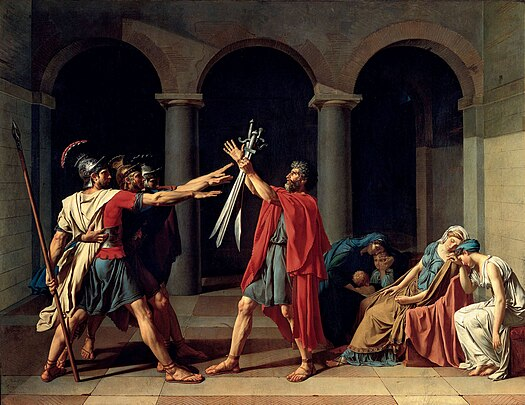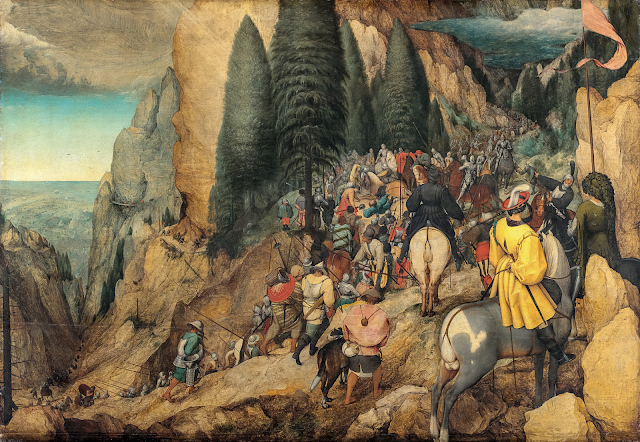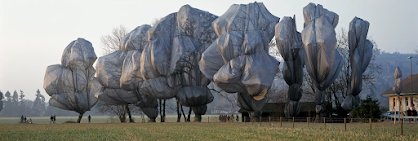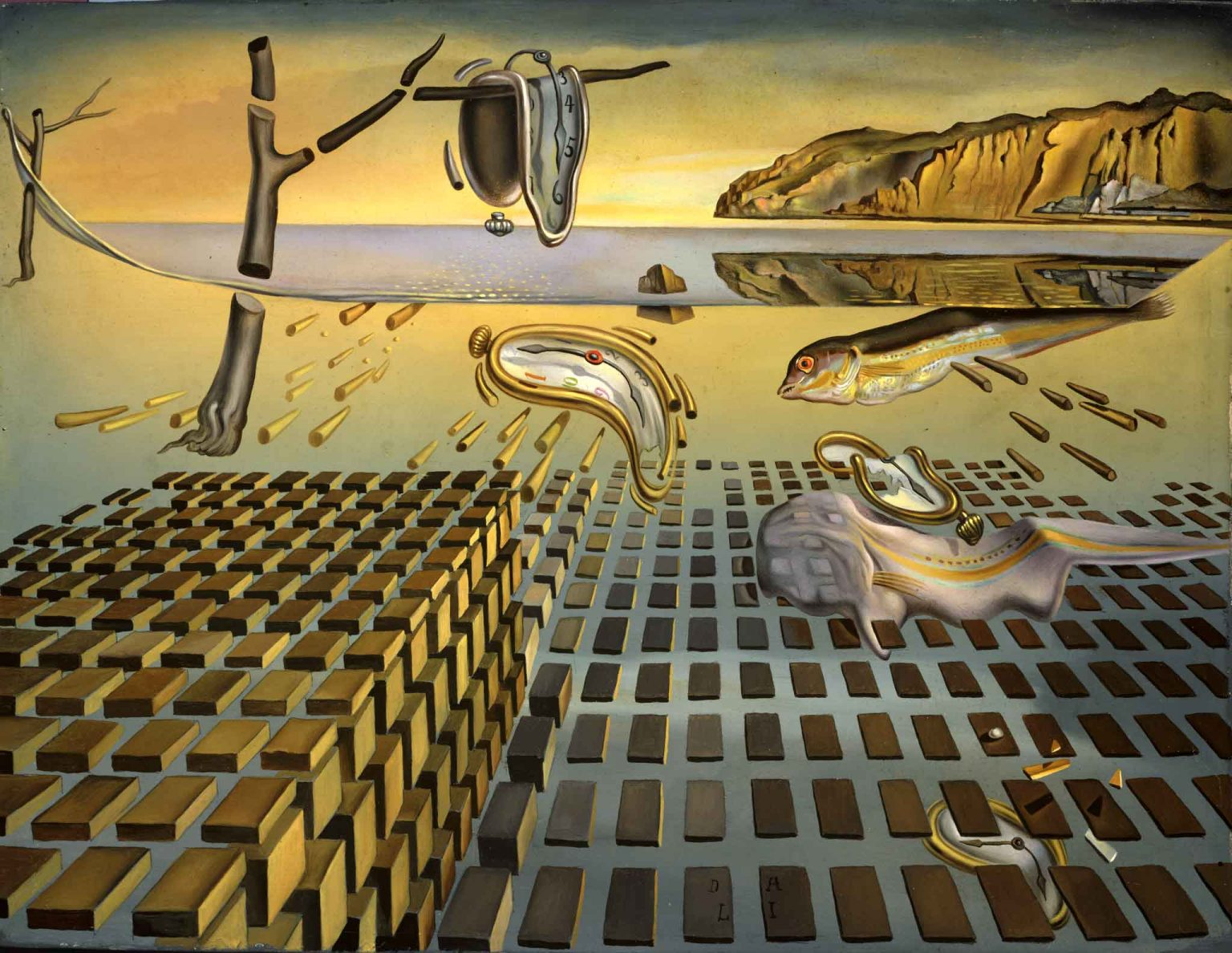Art of the French and American Revolutions
The Classical era contained two major historical events that helped shape the art of the time - the French Revolution and the American Revolution. The time of these wars contrasted greatly with the early Classical period. The early Classical era was a time in which the wealthy and the nobility lived lavishly and there was relative peace throughout Europe and America. The neoclassical era was marked by an uprising against these aristocracies by the common people as they fought to free themselves from oppressive rulership. The art of the Early Classical and Neoclassical periods reflect the changes that occurred during the Classical period very well. The lavish portraits and architecture of the beginning of the Classical era made way for paintings displaying the heroism. loyalty, and bravery that were desirable at the time. The focus of the art of this time also shifted from the rich and important people to commoners and soldiers.
Oath of the Horatii (1784) by Jacques-Louis David
Oath of the Horatii is a well-known work of Neoclassical art depicting an ancient Roman scene. This painting was commissioned by the assistant to one of the French kings. He wanted it to encourage loyalty to the state, but David instead painted the scene in such a way that it displays patriotic sacrifice, a defining concept of the French Revolution. It was completed five years before the French Revolution, and it is full of the ideals and values that initiated the Revolution. The painting depicts three Roman brothers being sent to fight for their city. Their father hands them their swords, and some women, one of whom is their sister, weep over the brothers' valiant sacrifice. David painted it while in Rome, and it currently resides in the Louvre Museum in Paris.
The first thing I notice about this painting is that almost everything comes in sets of three. There are three brothers, three swords, three women, and three arches in the background. This number gives a sense of balance and "rightness." The people and clothes have natural, flowing shapes, while the floor and arches are made from straight linear shapes. The geometric shapes give a feeling of strength and stability to the people in the foreground. Like many Neoclassical paintings, this one is very linear. the columns create two vertical lines that divide the scene into three sections, each one containing a different group of people. The people take up most of the bottom half of the painting, but hardly any of the top half, further dividing the painting. There are also numerous diagonal lines and triangles formed by the people in the painting. All of the elements of art in this painting make it look balanced and stable, despite the tension and drama of the scene. This communicates the message that the heroic sacrifice of the brothers is desirable and good. Of the three paintings in this blog, this is the only one I wouldn't mind owning a copy of. It doesn't overtly display scenes of fighting and death, the other two paintings do. The straight lines and triangles formed in the painting also make the work appealing to look at. The Storming of the Bastille (1790) by Jean-Baptiste Lallemand
The Storming of the Bastille depicts the first violent conflict of the French Revolution. The Bastille was a symbol of the power of the wealthy aristocracy of France. When civilians overtook the castle, it was not for personal gain or strategic advantage, it was seen as a patriotic conquest for freedom. Lallemand wanted to paint this work with the perspective of the common people in mind. Lallemand was one of these French commoners at this time. It was painted in France, likely in or near Paris, and can be found today in the Carnavalet Museum in France.
The color and tone in this painting creates a strong contrast between the upper and lower portions of the painting. The top of the painting is mostly just sky and the castle. It is painted using cool, light pastel colors. This makes this part of the painting seem detached and peaceful. The bottom of the painting dramatically contrasts the top half. It is crowded with people, but none of these individuals seem to be the primary focus of the painting. The colors are dark and the space is chaotic and smoke-filled. It seems like this painting isn't meant to be an idealized depiction of the event, but rather tells about the scene how it actually happened. This paining, like the Oath of the Horatii, shows the ideals of the French Revolution, but it shows what bravery and self-sacrifice actually look like rather than an idealized version of them.
I don't think I would want a copy of this painting. It's very chaotic and violent. I do really like the colors of the Bastille and sky in the upper half of the painting. If it weren't for the bottom half of the painting, I could see myself owning a copy of this painting.
The Death of General Mercer at the Battle of Princeton (1789-1831) by John Trumbull
Unlike the two previous paintings, this one is from the other major conflict of the Classical period, the American Revolution. In this painting, John Trumbull condenses the events of an entire battle onto one canvas. The focus of the painting is supposed to be General Mercer being killed by British soldiers, but there is so much happening that it's difficult to focus only on his death. You can also see General Washington leading the troops from atop his horse. The American flag seen next to him helps draw the viewer's attention to this part of the painting. I think that Mercer is supposed to symbolize patriotic self-sacrifice, while Washington symbolizes beavery and leadership.
The color white is used to draw attention to the figures in the center of the painting. General Mercer is laying over the body of his white horse, and George Washington is standing in front of a cloud of white smoke. The smoke adds confusion to the scene, much like it does in The Storming of the Bastille. This panting has more visual depth than Oath of the Horatii, but it is still very linear. The soldiers in the painting make an X shape, with Mercer, his assailants, and Washington at the center. This makes the painting look very balanced. The stable, balanced feeling that this painting creates, paired with the focus on Washington and Mercer, makes their actions look commendable and strong.
At first, I thought this painting was too chaotic and violent to own a copy of. After looking at it in more depth, however, I noticed that this painting has a lot of structure to it. The use of colors is also appealing to me. The colors that stand out the most are red, white, and blue. I wonder if Trumbull did that on purpose. This painting displays American patriotism very well. It might be cool to own a copy of it.
Works Cited
artst. “10 Most Famous French Revolution Paintings.” Artst, 25 Jan. 2022, www.artst.org/french-revolution-paintings/.
du Plessis, Alicia. ““Oath of the Horatii” by Jacques-Louis David - an In-Depth Analysis.” Artincontext.org, 8 Feb. 2023, artincontext.org/oath-of-the-horatii-by-jacques-louis-david/.
Kific, Armin. “Famous French Revolution Paintings - the Art of the French Revolution.” Artincontext.org, 18 May 2022, artincontext.org/famous-french-revolution-paintings/.
“Neo-Classicism and the French Revolution.” Oxford Art Online, Oxford University Press, 2024, www.oxfordartonline.com/page/1625.
“Ten Great Paintings of the American Revolution.” The American Revolution Institute, www.americanrevolutioninstitute.org/treasures-of-the-american-revolution/ten-great-american-revolution-paintings/.
“The Death of General Mercer at the Battle of Princeton, January 3, 1777 | Yale University Art Gallery.” Yale University Art Gallery, 2020, artgallery.yale.edu/collections/objects/101.






I enjoyed reading your blog on the classical era. I found Storming of the Bastille interesting after watching The Crown and Harry & Meghan. It's interesting to learn about the monarchy before Queen Elizabeth's time. There is so much death, and seems like such a dark time in history. The painting depicts how dark it was. I like how they painted the portrait to depict smoke or smog from the gun fire and the fires itself. Great portrait choices!
ReplyDeleteI really liked reading your blog. I would have to agree that the American Revolution and French Revolution helped to shape the art of that time. Many artists used their work as propaganda and to push certain ideals. Some of the greatest achievements of the artistic propaganda here appear through historical and allegorical painting. Jacques Louis David was one of the most prominent revolutionary artists of the time in France (Blair). In his painting Oath of Harvatii that you talked about was something I used too. I find so many neat elements in the painting. Did you notice how all the red is muted but the father who is handing his sons their sons? This shows some patriotism with the brothers taking the oath to protect Rome which shows morals that were popular during this period too. Thank you for sharing your perspective!
ReplyDeletehttps://digitalcommons.wku.edu/stu_hon_theses/102/
I am very grateful that you have taken the time on each of these pieces to give a proper background on the subject matter, it makes analyzing them so much more enjoyable! without knowing the backgrounds though i still really love seeing the compositional similarities between all of these pieces. I also find it super interesting the different artists perceptions of self sacrifice, either in the battlefield or in a more personal scene like that of Oath Of Horatii. you have done a good job following the inspirations of the different revolutions through these pieces and I commend your job of breaking them down into their artistic elements.
ReplyDelete